Spruce budworm population behaviour
This is a research project done by me and submitted as a part of an assignment.
Reference usage only.
Abstract
Spruce budworm’s population dynamics are observed and recorded in recent decades, and the mathematical model describing the population of the budworm is fitted and its features are highly related to budworm’s real-life population behaviours and thus have great biological significance in forest protection and pest prevention.
A homogeneous budworm model is studied in the first section. It gives the bifurcations and conditions for the stability. The periodic transfer between two population levels and time evolution path are studied.
With diffusion considered, the spatial model in one dimension is given with varies conditions and their corresponding situation for the budworms. Biological waves are also studied.
Introduction
Spruce budworms’ behaviour represents one classic biological model in the diverse ecosystem, in which the populations of species are usually described by differential equation. The spruce budworm is studied as it destroys forest and break ecosystem balance.
In this mathematical model, with birds’ and other creatures’ predation considered, the partial differential equation described a population dynamic with interesting behaviours, which have realistic significance and explains what have been observed in real-life forest1. The number of budworms can be steady at different levels, which correspond to the steady states of the equations.
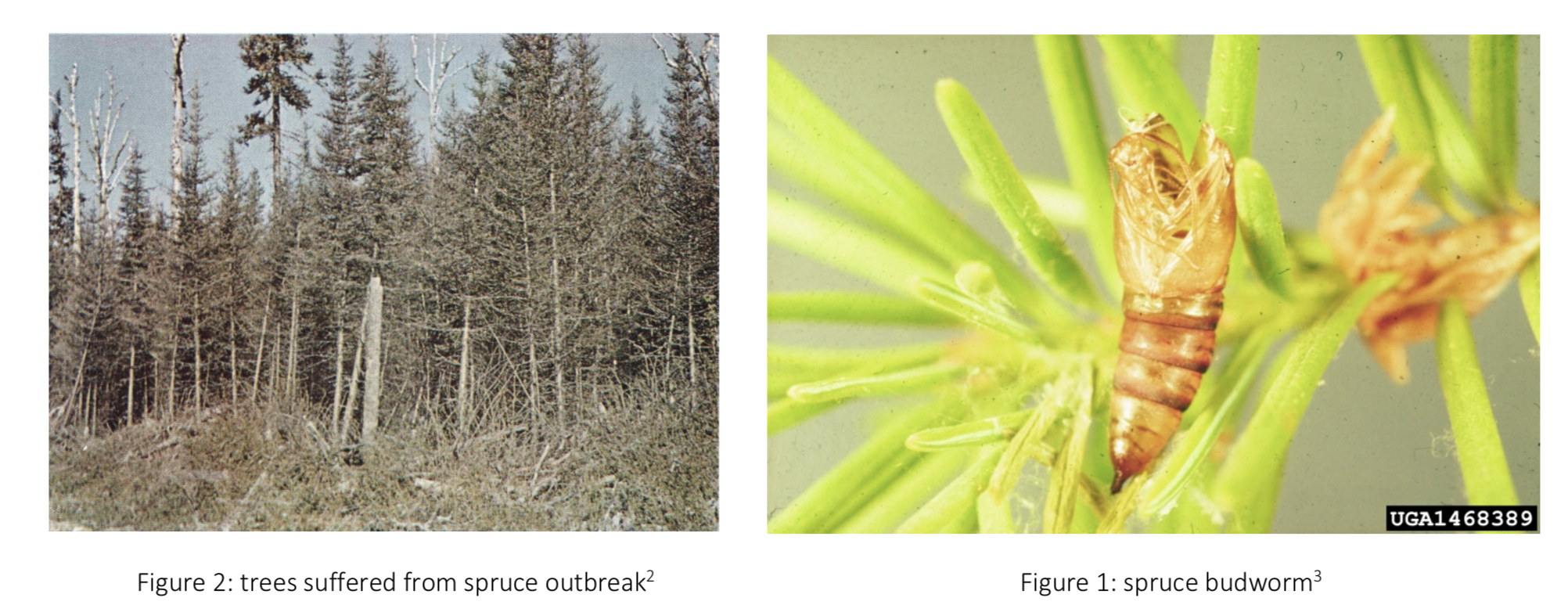
The number of spruce budworms remains at a low level (known as refuge level) for most of time, but it would see an outbreak and reach at a higher level (outbreak level) with catastrophic effects on forest. This periodic transfer between the two levels are motivated by the external changes e.g. living environment, and as a result, the carrying capacity varies with the spruce budworm population. Once the environment could afford a larger population, the refuge level becomes unstable and grows to an outbreak level, at which the budworms’ activities destroy forest (figure 1) and in return, turn down the environment capacity, thus the system cannot support such number of budworms and the population would drop to the relative less-harmful refuge level.
This game between the budworms and forest also involves spatial diffusion. As the budworms are distributed among the forest, a dynamic density distribution is observed, where the diffusion of population concentration and biological waves are shown.
The dynamics rises awareness of protecting the forest and pest control with the aim to avoid outbreak level. The dynamics and behaviours of budworm population can be described with differential equations, and PDE behaviours correspond to different population states, thus studying on the mathematical model would help us in predicting the forward trend of the budworms and apply pest prevention in advance.
Homogeneous budworm model
The population of the homogeneous spruce budworm can be modelled as
It is a variant of the continuous logistic population model with the predation term
Steady states and their stability
The steady states
The second case comes with a cubic equation, which could have zero, one two or three roots depending on the parameters. The analytic solution is too complex to present here. These steady states can be demonstrated from the graph below.
The stability can either be determine from the graph by tangent lines or the sign of
Case 1: denote the roots of
Case 2: denote the roots of
Case 3: denote the roots of
Case 4: denote the roots of

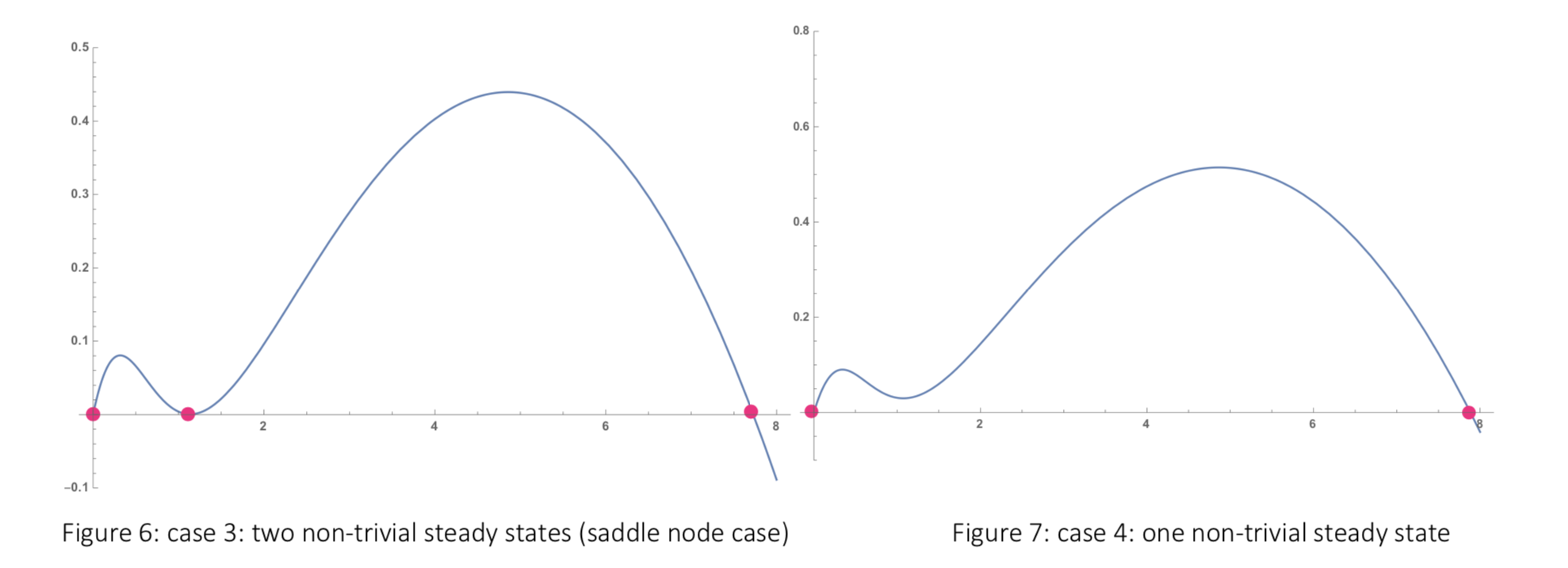
The time evolution of these four cases is discussed in later section, with different staring points considered.
Bifurcations and tangency condition
Case 3 is a state between case 1 (three non-trivial steady states) and case 4 (one non-trivial steady states). While one of the parameters r, q is fixed and the other varies, there is a changing point where the number of non-trivial steady states reduce to 1 from 3, or increase to 3 from 1.
Suppose q is set to 10 and r changes, the plot of
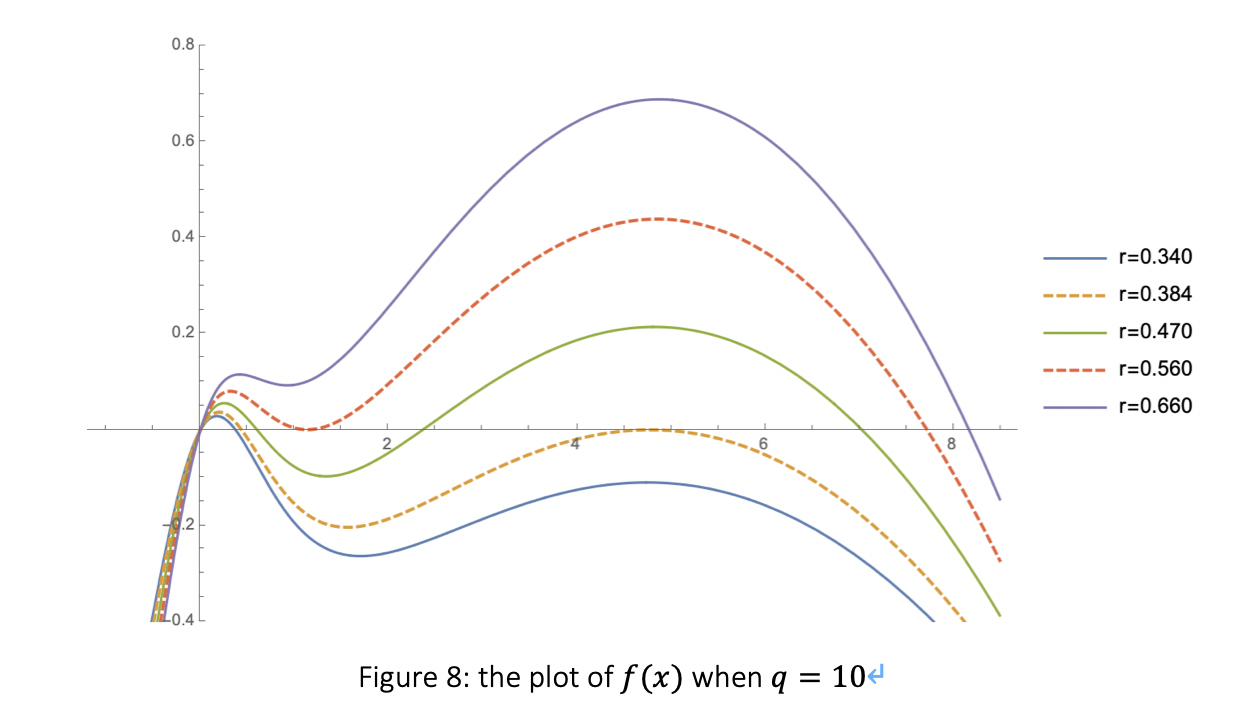
As dashed line indicates, there are two cases where part of the curve is tangent to the x-axis. When r increase from 0.340 to 0.660, the changes of the number of non-trivial steady states is
i.e. one steady state
The tangent condition is given as
For q=10, we can find numerical solutions

The r values agrees with the plot above.
Generally, the tangent condition can be expressed by

The parametric plot of r against q is shown below (figure 9):
The coordinate plane is divided into two regions: Ⅰand Ⅱ (figure 10). Accord to this plot, the number of non-trivial steady states can be determined, i.e. the cusp condition:
If parameter r, q are fixed and
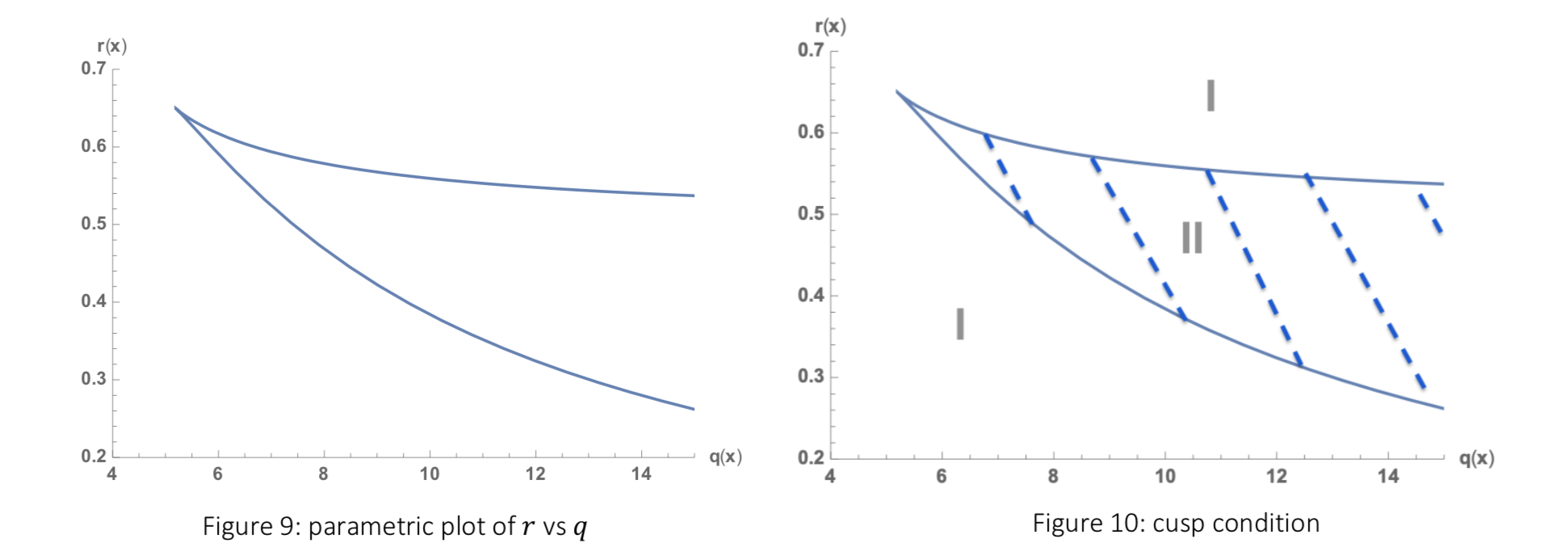
This condition also meets the example above, where q=10 and r increases from 0.340 to 0.660. Point
Time evolution of the population
The time evolution or population trend can be visualized by the vector field on the x-axis. This evolution trend is validated in a programme.
- Case 1:
- Case 2: there is only refuge level at
- Case 3: this case represents two tangent conditions. The first one would see an outbreak level, while the second one would see a refuge level (figure 13).
- Case 4: there is only outbreak level at
This cusp condition can be simplified, when one of the parameters is fixed. E.g. if r is fixed, then the behavior of the population is only determined by q. The exact solution for u and q of the differential equation can be extremely complex, but two critical values of q are in the solution, i.e.
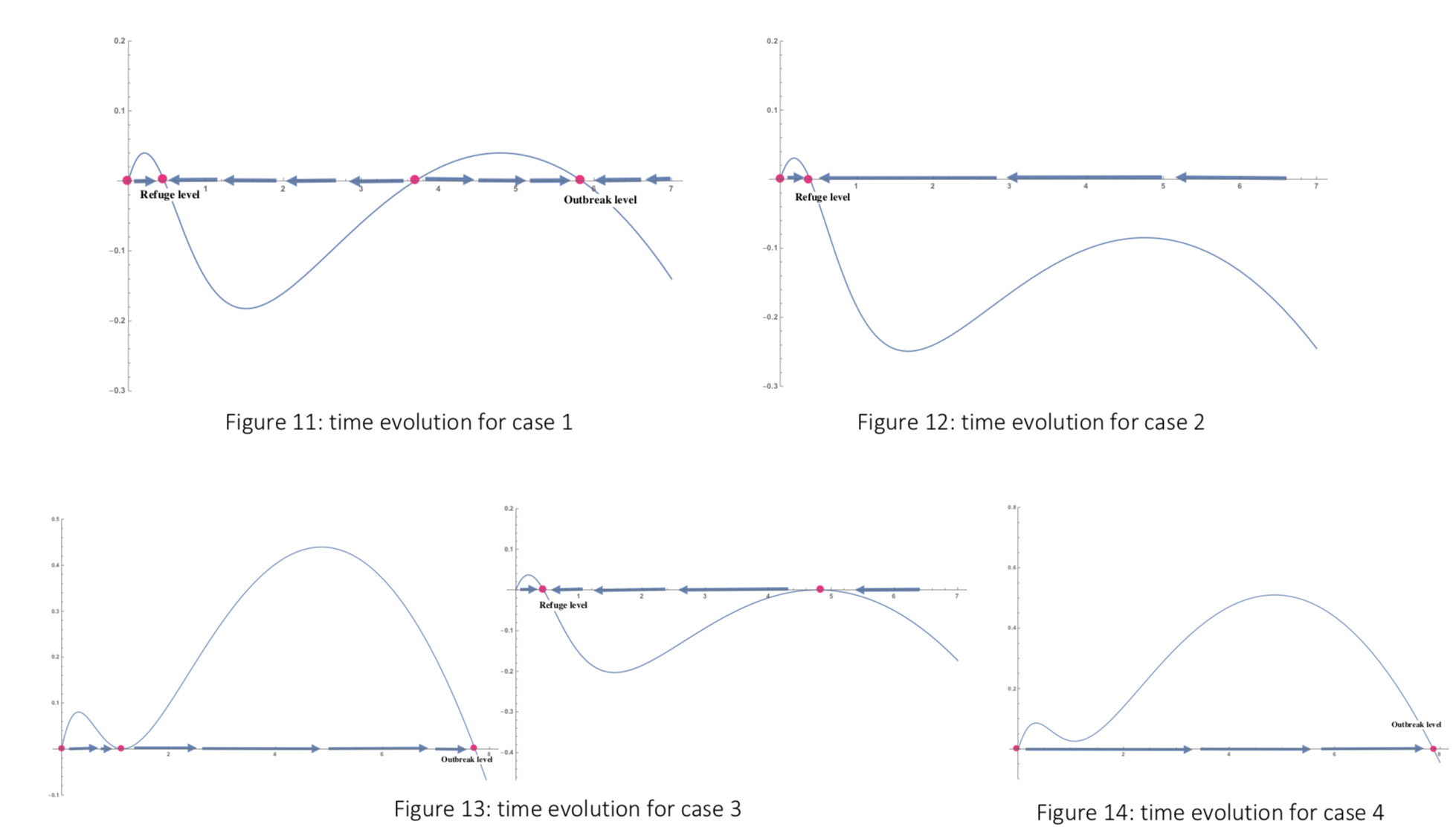
Evolution path
The budworm population can reach refuge level or outbreak level as time passes. In real-life, the budworm population can be catastrophic when at an equilibria of outbreak level, as the budworm may destroy the forest and break local ecological balance. It may happen that started in case 4, budworm population reaches outbreak level and result in carrying capacity q dropping to a level where only refuge level exists (i.e. case 2). Then the population will drop to the refuge level. Consequently, population in refuge level helps forest recover and q rises, followed by the same oscillations. In this case a hysteresis loop is obvious, where the path from outbreak level to refuge level and the return are not the same.
To simulating this, the q is set to be a function on time:
in this example,
The oscillation between outbreak and refuge mainly results from time-dependent q: it determines a jump between the two equilibria. The hysteresis tells that while forest destroyed, it is slow for species like budworm to develop firstly; also forest broken would cause instantly negative affect such that population would drop all the way to refuge level, where forest starts to recover.
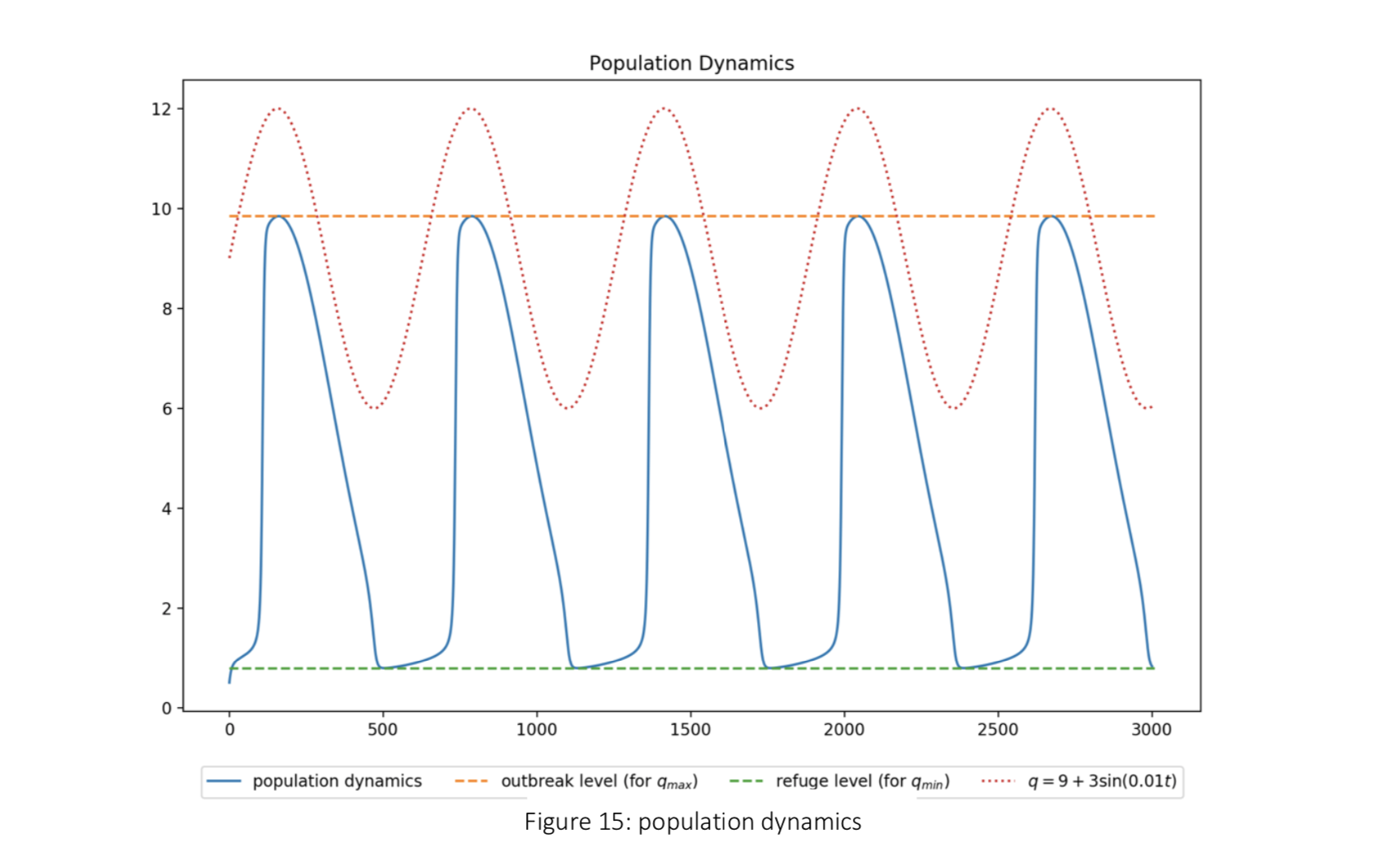
Diffusion model
Let
where the term f(u) explains the population dynamics,
Spatial behaviour and bifurcations
In one dimension (on a line
Under fixed boundary condition
Plot the curve of f(u) and line
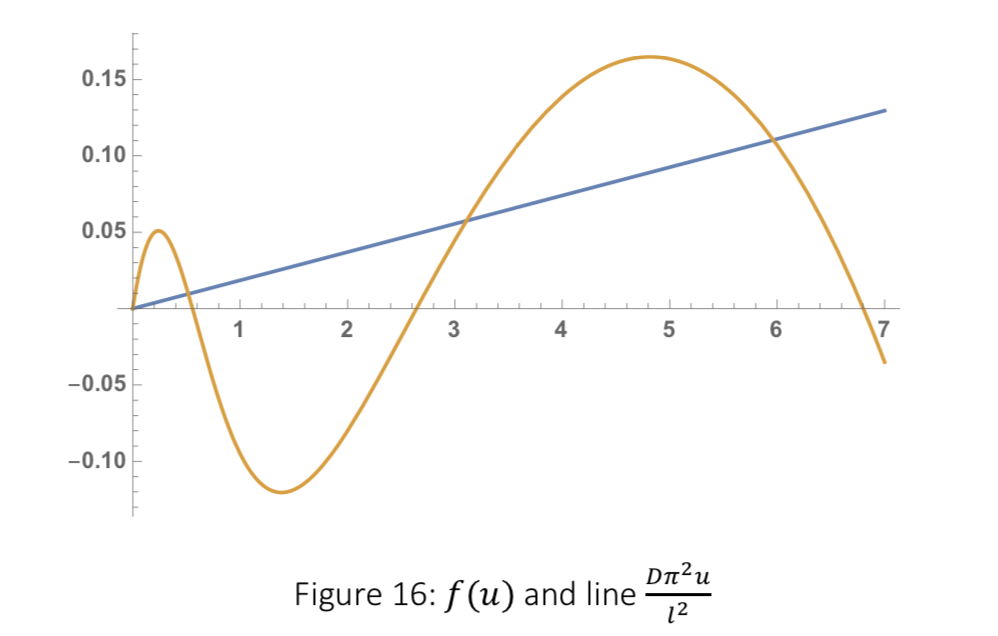
The number of intersections can be 1, 2, or 3, and these cases have similar behaviour as discussed in the model without diffusion. In the model without diffusion the evolution is determined by the roots, i.e. the intersections of the curve f(u) and x-axis, but in diffusion model the evolution is determined by the intersections of the curve f(u) and line
In the model without diffusion, the tangency condition is where part of the curve is tangent to the x-axis while in diffusion model, part of the curve is tangent to the line

While parameters q and D are fixed, the numerical solution can be found as pairs of
The bifurcation depending on r can be described as:
- if
- if
- if
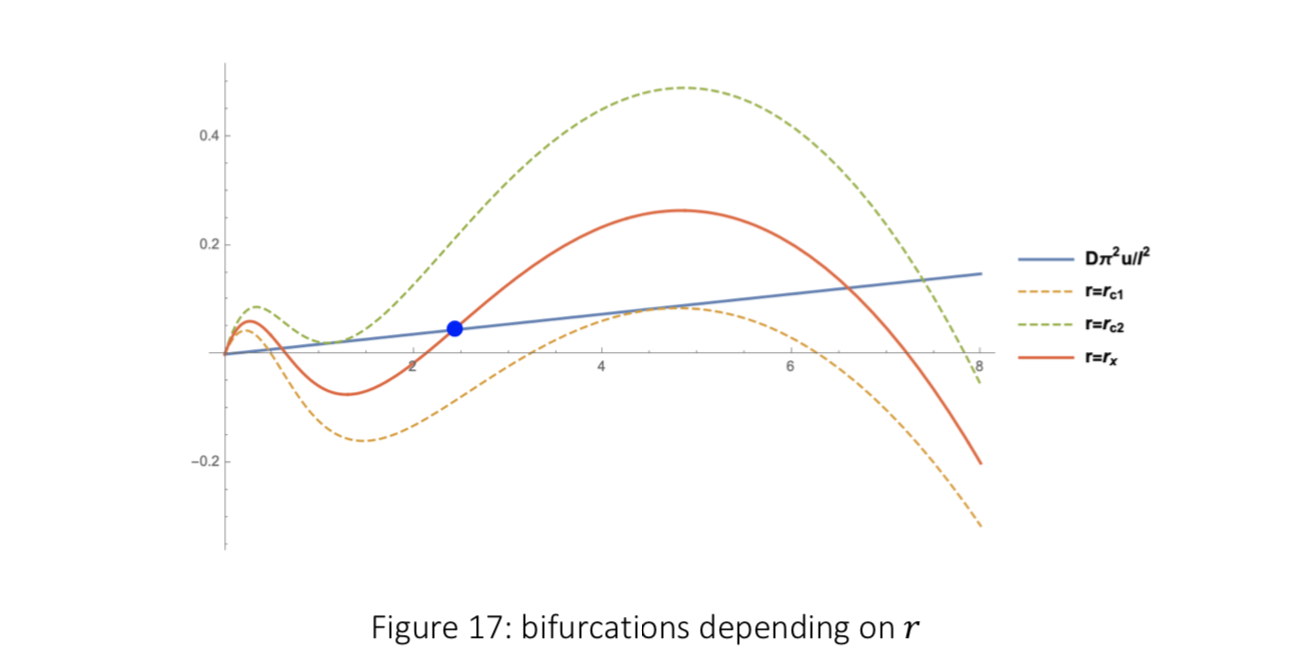
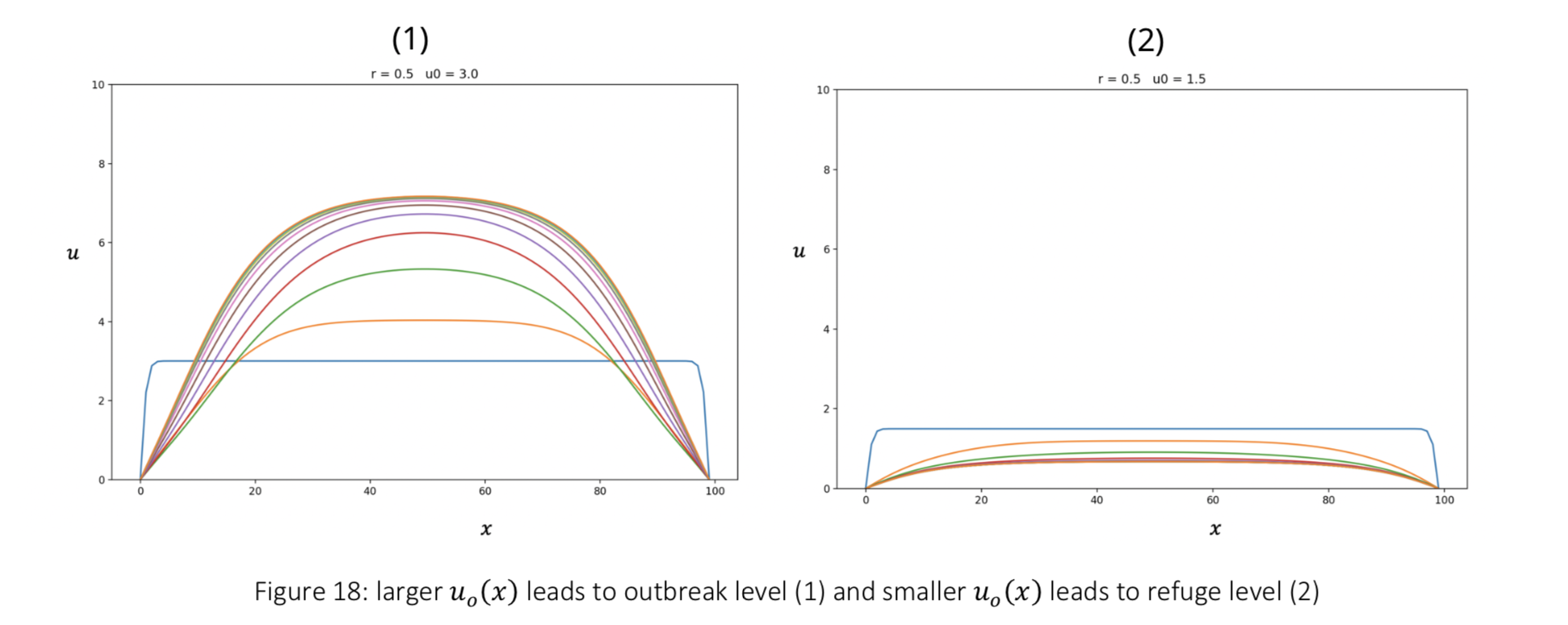
Wave
A diffusion wave could be observed when the initial distribution is properly placed in the space
The position of the
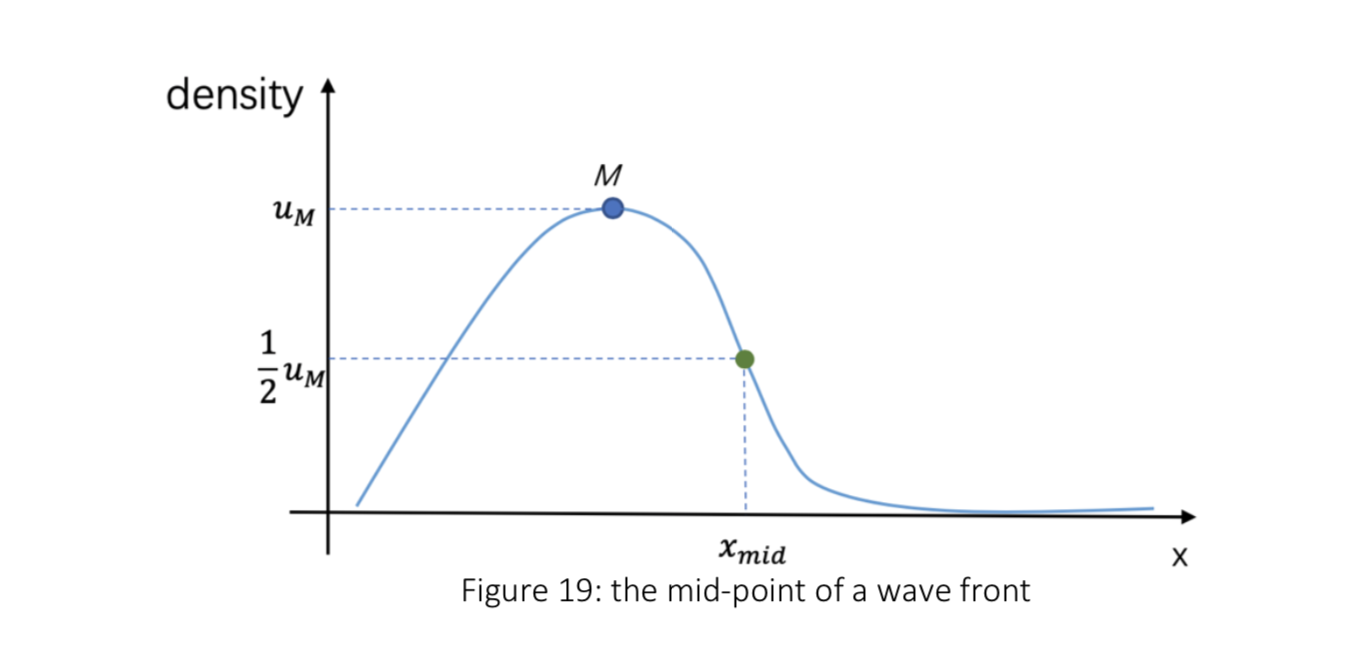
Examples
In these examples,
Example 1: the budworms are localised uniformly in the first half of the space, with initial values
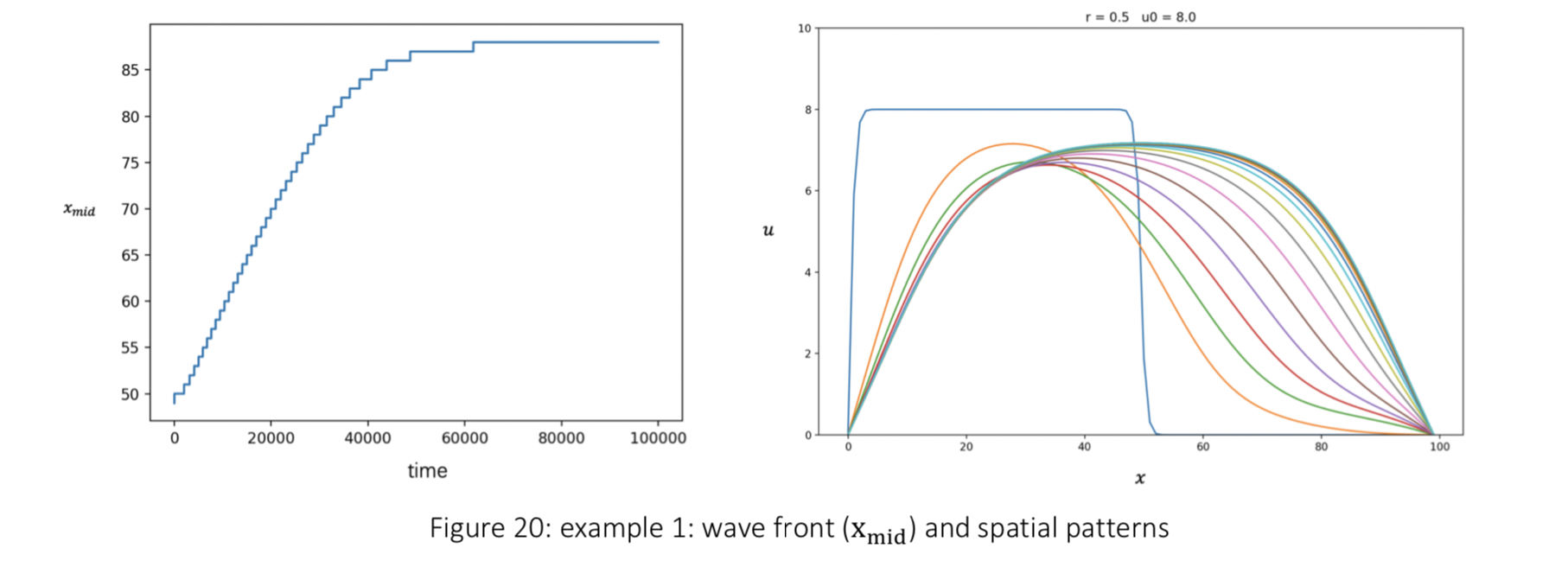
Example 2: the budworms are localised in a single point where
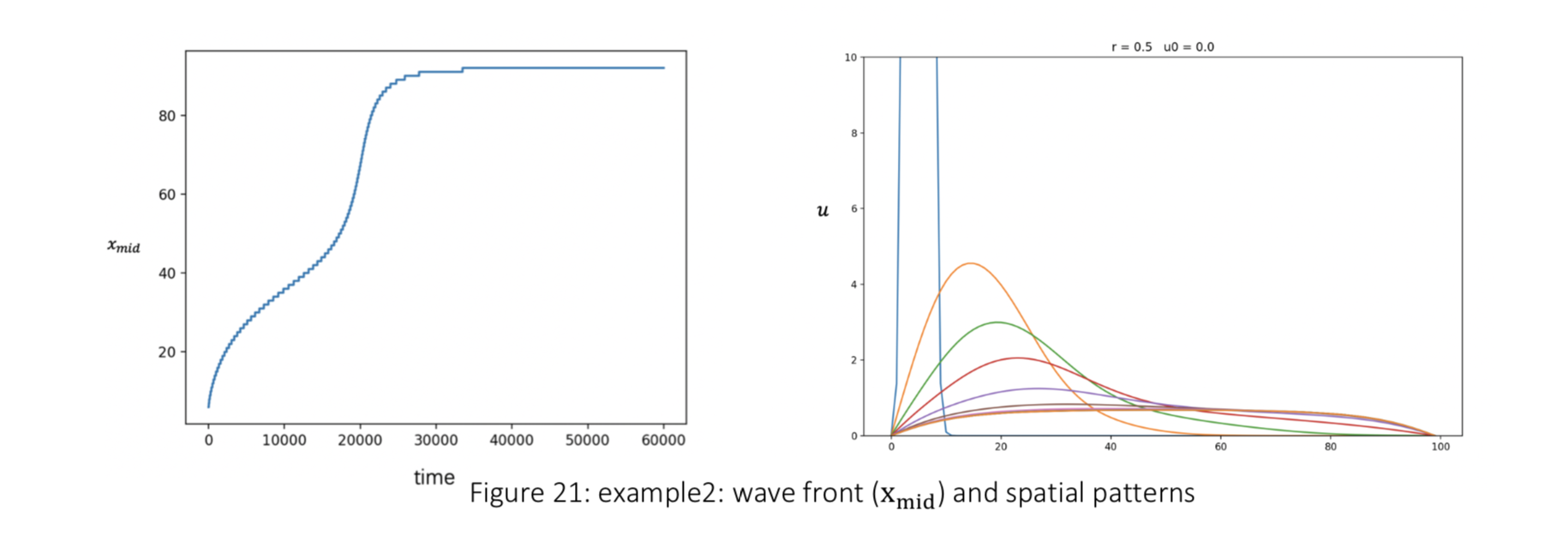
Conclusions and outlook
Bifurcations and complex conditions arise when adding an extra term to the basic logic model. The equation for spruce budworm model has a special curve shape thus it has up to 3 solutions in certain condition. The complexity is shown in the evolution path when changing parameters.
The spatial behaviour is also model as an extension of the equation with diffusion term added, in this case the relationship between the line
These models are helpful in predicting the forward movement of the budworm population, with parameters given.
However, the model cannot represent exactly the real-life dynamics and consider all the factors that influence the budworm. Also, the assumptions in the diffusion model that
Diffusions in higher dimensions have been studied with more complicated PDE method^4. The possible improvement of the model includes using the explicit environment system, or making corrections using real-life observations (e.g. adding another term to the equation to describe the system more specifically).
Reference
[1] Powell, Jerry A., ed. Biosystematic studies of conifer-feeding Choristoneura (Lepidoptera: Tortricidae) in the western United States. Vol. 115. Univ of California Press, 1995.
[2] Morris, R. F. (1963). The dynamics of epidemic spruce budworm populations. The Memoirs of the Entomological Society of Canada, 95(S31), 1-12.
[3] R. G. Van Driesche et al, Forest Pest Insects in North America: a Photographic Guide, https://www.forestpests.org/vd/index.html
[4] Singh, M., Easton, A., Cui, G., & Kozlova, I. (1998). NUMERICAL STUDY OF THE TWO‐DIMENSIONAL SPRUCE BUDWORM REACTION‐DIFFUSION EQUATION WITH DENSITY DEPENDENT DIFFUSION. Natural Resource Modeling, 11(2), 143-154.
Appendix
Python Code
homogenous model
1 | # Population Dynamics, time evolution |
diffusion model, time evolution
1 | # diffusion model, time evolution |
diffusion model, wave front
1 | # diffusion model, wave front |